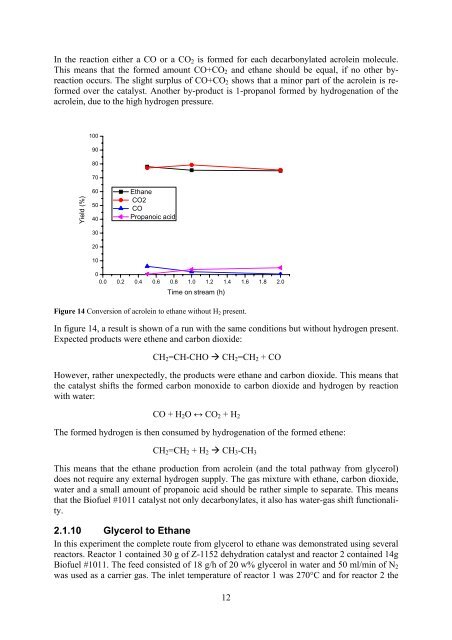Rapport SGC 198 Bio-Propane from glycerol for biogas addition
Rapport SGC 198 Bio-Propane from glycerol for biogas addition
Rapport SGC 198 Bio-Propane from glycerol for biogas addition
- No tags were found...
You also want an ePaper? Increase the reach of your titles
YUMPU automatically turns print PDFs into web optimized ePapers that Google loves.
In the reaction either a CO or a CO 2 is <strong>for</strong>med <strong>for</strong> each decarbonylated acrolein molecule.This means that the <strong>for</strong>med amount CO+CO 2 and ethane should be equal, if no other byreactionoccurs. The slight surplus of CO+CO 2 shows that a minor part of the acrolein is re<strong>for</strong>medover the catalyst. Another by-product is 1-propanol <strong>for</strong>med by hydrogenation of theacrolein, due to the high hydrogen pressure.100908070Yield (%)605040302010EthaneCO2COPropanoic acid00.0 0.2 0.4 0.6 0.8 1.0 1.2 1.4 1.6 1.8 2.0Time on stream (h)Figure 14 Conversion of acrolein to ethane without H 2 present.In figure 14, a result is shown of a run with the same conditions but without hydrogen present.Expected products were ethene and carbon dioxide:CH 2 =CH-CHO CH 2 =CH 2 + COHowever, rather unexpectedly, the products were ethane and carbon dioxide. This means thatthe catalyst shifts the <strong>for</strong>med carbon monoxide to carbon dioxide and hydrogen by reactionwith water:CO + H 2 O ↔ CO 2 + H 2The <strong>for</strong>med hydrogen is then consumed by hydrogenation of the <strong>for</strong>med ethene:CH 2 =CH 2 + H 2 CH 3 -CH 3This means that the ethane production <strong>from</strong> acrolein (and the total pathway <strong>from</strong> <strong>glycerol</strong>)does not require any external hydrogen supply. The gas mixture with ethane, carbon dioxide,water and a small amount of propanoic acid should be rather simple to separate. This meansthat the <strong>Bio</strong>fuel #1011 catalyst not only decarbonylates, it also has water-gas shift functionality.2.1.10 Glycerol to EthaneIn this experiment the complete route <strong>from</strong> <strong>glycerol</strong> to ethane was demonstrated using severalreactors. Reactor 1 contained 30 g of Z-1152 dehydration catalyst and reactor 2 contained 14g<strong>Bio</strong>fuel #1011. The feed consisted of 18 g/h of 20 w% <strong>glycerol</strong> in water and 50 ml/min of N 2was used as a carrier gas. The inlet temperature of reactor 1 was 270°C and <strong>for</strong> reactor 2 the12
















